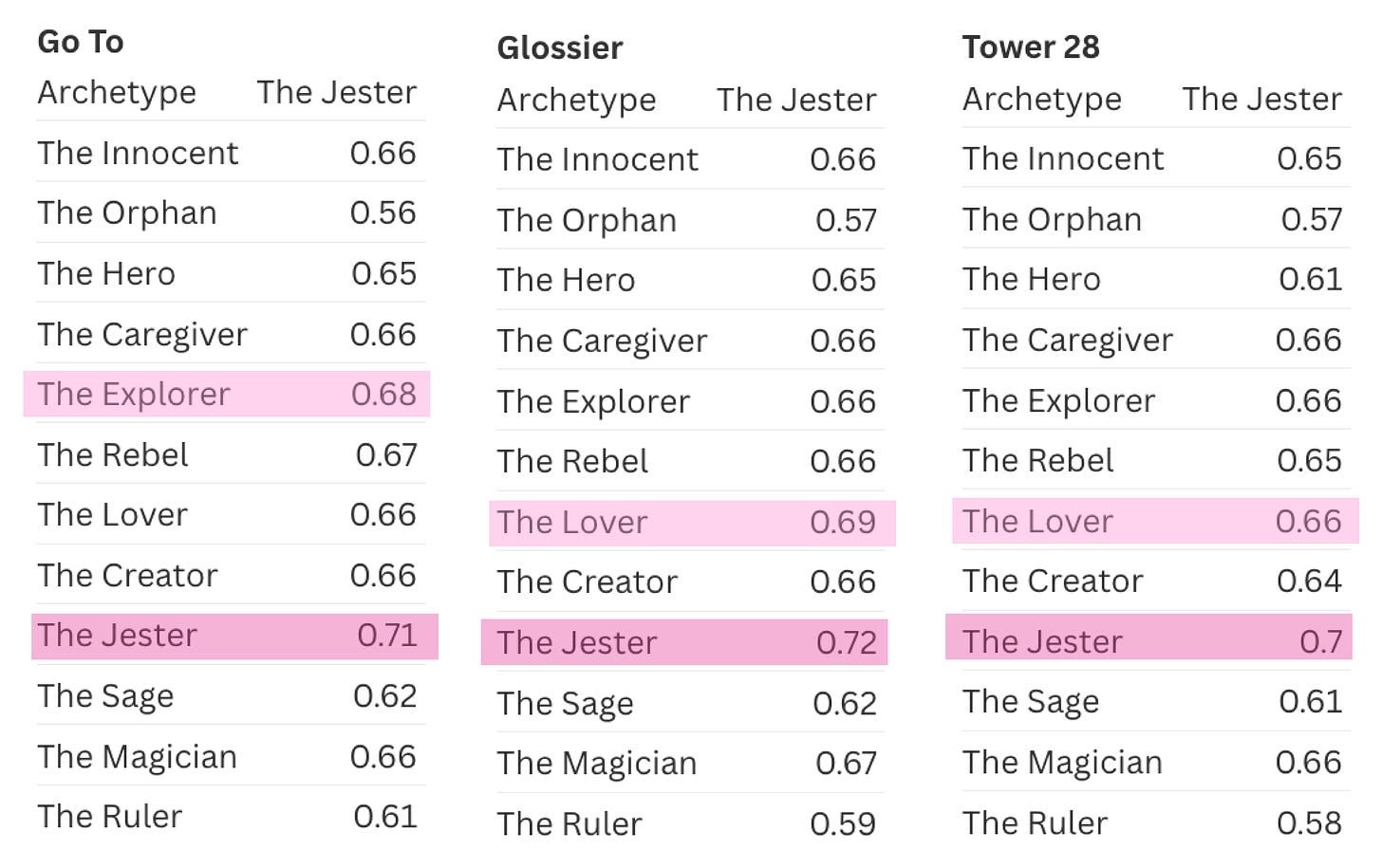Copywriting in Beauty: Decoding Brand Archetypes
Analysing 205 Prestige Beauty Brand Descriptions
Copywriting is an art form. As someone who is more fluent in numbers than in words, I’ve always been fascinated by the impact of language on beauty branding.
How can two brands with nearly identical products, packaging, and social media strategies evoke completely different emotions? How can the same shade of pink feel soft and feminine for one brand yet rebellious and tomboyish for another? The answer lies in the nuances of language—how words shape perception, personality, and world-building.
This week, I set out to explore how beauty brands craft their identities through language by analysing their brand descriptions. I collected the descriptions of 205 prestige beauty brands and measured how closely each brand aligns with twelve distinct archetypes. By calculating similarity scores, I developed radar charts to uncover patterns across the industry.
In this report, we will analyse the competitive landscape to help beauty professionals understand the strategic positioning of different brands—and, more importantly, how each brand communicates a distinct set of values.
The full analysis, interactive graphs, and raw data are available behind the paywall.
The Archetypes
In the 1940s, psychologist Carl Jung introduced a set of personality archetypes, which he believed were innate. Jung’s framework outlines 12 core archetypes, each representing fundamental human values, motivations, and ideals.
In branding, these archetypes are essential for defining a company’s identity, messaging, and the emotional bonds it creates with consumers. While there is overlap and emotions don't always fit neatly into twelve categories, these archetypes offer a helpful framework for communicating effectively with customers. For today’s analysis, we will use this framework as our foundation.
The 12 archetypes are connected to four key human motivations: stability, mastery, independence, and belonging. These core drives shape how brands communicate and resonate with their audiences.
What brand would want to communicate feelings of being an orphan? Great question. No one! In fact, none of the 205 brands analysed were most aligned with the orphan archetype. While there are twelve archetypes, some are far more dominant within the beauty industry.
Method
After collecting the descriptions of 205 brands, I used spaCy, a natural language processing (NLP) tool—a branch of AI designed to help computers interpret human language—to process the brand descriptions.
I then employed cosine_similarity from sklearn to compare the similarity between the brand descriptions and the archetype definitions from this blog post. This process generated a similarity score for each archetype for every brand, with scores ranging from 0 to 1.
Radar Charts
By using the link to the live data below, you can filter the brands by archetype. For example, filtering for 'The Jester' will quickly reveal that brands in a single archetype are not necessarily similar.
While they share the same primary archetype, each brand has varying levels of similarity to other archetypes. This demonstrates the usefulness of the radar chart, as it allows us to visually compare and understand the dimensions of similarity across multiple archetypes for each brand.
‘The Jester’ as an archetype is described as being a "playful and fun." This is obvious in brands like Go-To, Glossier, and Tower28. By accessing the live data and clicking on each of these brands, we can examine their similarity scores for each archetype.
Notice how 'The Jester' is 0.03 or more similarity points away from the next most similar archetype? This is because the playfulness of ‘The Jester’ archetype is especially strong among these three brands.
If we compare this to brands like Tocca, Tom Ford, and Vyrao, which were also categorised as ‘The Jester,’ we can see that they are only 0.02 or fewer similarity points between ‘The Jester’ and the next most similar archetype.
This helps us understand that while Tocca describes itself as "free-spirited," which the model identified as similar to "spontaneous," a key trait of "The Jester," it is also closely linked to "The Explorer" archetype through its description as "inspired by travel." The same can be said for Tom Ford and Vyrao, which share traits of both ‘The Jester’ and ‘The Explorer’.
Radar charts and similarity scores are helpful by capturing nuances between brands. Additionally, the analysis was influenced by the amount of brand copy available, which explains why similarity scores are often close.
Analysis
With this in mind, we can now examine the patterns and trends across the entire dataset. To explore and interact with the brand radar graphs yourself, follow the link below to the Flourish page, where all of this data is readily available.









